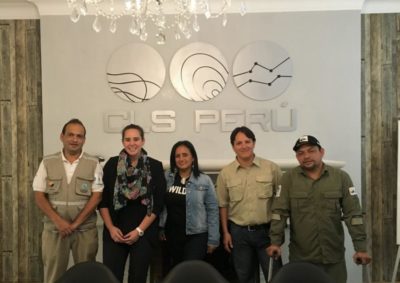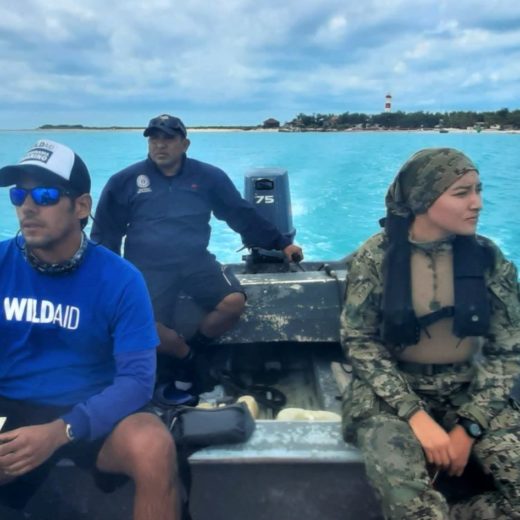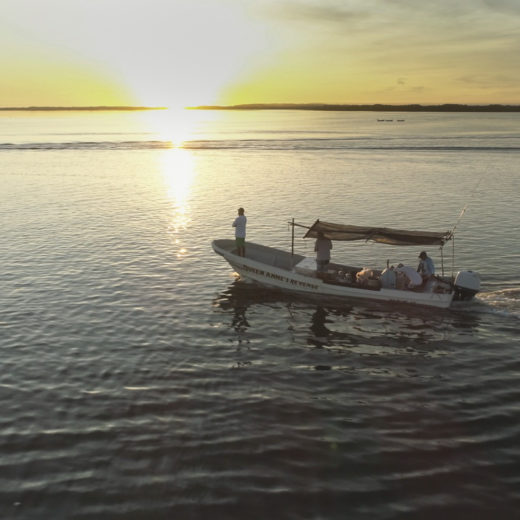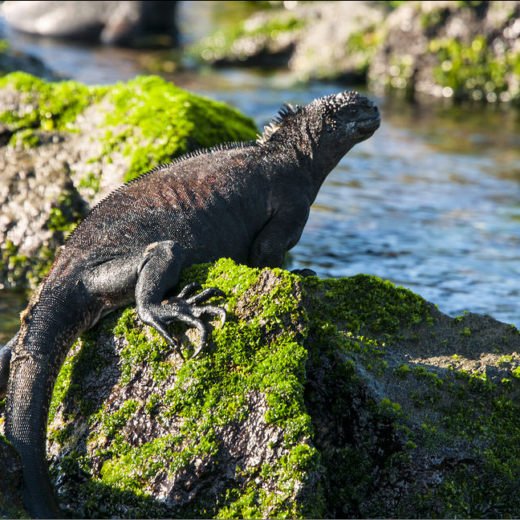
This week, WildAid and CLS coordinated a peer exchange between Galapagos park rangers and members of the Peruvian Coast Guard to share their experiences in using electronic technology for surveillance of marine areas.
The Peruvian Coast Guard protects Peru’s marine natural resources, including three marine protected areas that together cover 2,400 square miles, as well as giant oceanic mantas, a species it shares with coastal Ecuador that were recently protected in Peru.
WildAid’s marine team works with the Ecuadorian Navy and Galapagos National Park Service to monitor the vast Galapagos Marine Reserve and prevent illegal fishing, including unsustainable practices that threaten mantas, sharks, sea turtles and dolphins that get caught on fishing lines as bycatch or are illegally targeted for the lucrative illegal wildlife trade. 

WildAid, Galapagos park rangers and CLS representatives outside Peruvian Coastguard offices
This year, we will install electronic monitoring software (AIS) to track small fishing vessels throughout the reserve, including in the new marine sanctuary at Darwin and Wolf. This new technology will complement existing technology (VMS) that tracks commercial fishing and tourism vessels within the reserve. Together, the two systems will allow park rangers to monitor nearly 100% of the 50,000-square-mile reserve.
Electronic surveillance technology has helped park rangers capture and sentence more than 100 industrial and small fishing vessels, such as the Maria Tatiana IV that was caught with 80 illegally caught sharks in its hold last month.
In this peer exchange the Peruvian Coastguard will demonstrate how their control center combines data using those same two systems (AIS and VMS) to monitor suspicious activity within their waters. This collaboration may also aid environmental officials from both countries in better protecting shared migratory species, such as giant mantas, sharks, humpback whales and sea turtles.
Thanks to the support of the Helmsley Charitable Trust, WildAid and CLS coordinated this exchange to train Galapagos park rangers on the use of the new technology and to develop best practices to improve enforcement of the reserve.
Español
Guardaparques de Galapagos Hacen Intercambio Con Guardacostas del Peru
Esta semana, WildAid y CLS coordinaron un intercambio entre los guardaparques de Galapagos y miembros de la Dirección General de Capitanías y Guardacostas del Peru (DICAPI) para compartir sus experiencias utilizando tecnología electrónica para monitorear espacios marítimos.
DICAPI protege los recursos marinos naturales de Peru, incluyendo sus tres áreas marinas protegidas cuales cubren mas de 6,000 kilometros cuadrados, y las mantarrayas gigantes, recientemente protegidas en Peru, y una especie que comparten con la costa de Ecuador.
Guardaparques de Galápagos y DICAPI en un intercambio en Peru
WildAid trabaja con la Armada Ecuatoriana y la Direccion del Parque Nacional Galapagos para monitorear la Reserva Marina Galapagos y prevenir la pesca ilegal, incluyendo practicas no sostenibles cuales amenazan a las mantarrayas, tiburones, tortugas marinas, y delfines que son capturados en las líneas de pesca incidentalmente o cazadas por el comercio negro.
Este año, vamos a instalar software de AIS para monitorear a las embarcaciones de pesca artesanales a través de la reserva, incluyendo en el nuevo santuario marino Darwin y Wolf. Esta nueva tecnología va complementar la tecnología existente para juntos monitorear la reserva entera.
Tecnología electrónica ayudó a capturar a mas de 100 embarcaciones de pesca industrial y artesanal, como la Maria Tatiana IV que fue capturada con mas de 80 tiburones en sus bodegas el mes pasado.
En este intercambio, DICAPI demonstró como su centro de control utiliza la tecnología para ayudar a sus guardaparques a mejor capturar la activdad ilícita en sus aguas. Esta colaboración también podrá ayudar que ambos países mejor protegan a las especies migratorias que comparten como las mantarrayas gigantes, los tiburones, las ballenas jorobadas, y las tortugas marinas.
Gracias al apoyo de Helmsley Charitable Trust, WildAid y CLS coordinaron este intercambio para capacitar a los guardaparques en el uso de nuevas tecnologías para mejorar la aplicación de la ley en la reserva.
Stay in touch and get the latest WildAid updates.
SIGN UPAbout WildAid
WildAid is a non-profit organization with a mission to protect wildlife from illegal trade and other imminent threats. While most wildlife conservation groups focus on protecting animals from poaching, WildAid primarily works to reduce global consumption of wildlife products such as elephant ivory, rhino horn and shark fin soup. With an unrivaled portfolio of celebrity ambassadors and a global network of media partners, WildAid leverages more than $308 million in annual pro-bono media support with a simple message: When the Buying Stops, the Killing Can Too.
Journalists on deadline may email communications@wildaid.org


